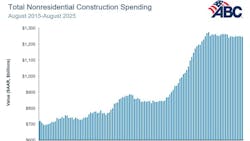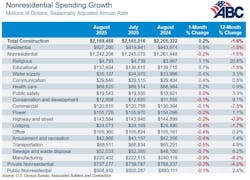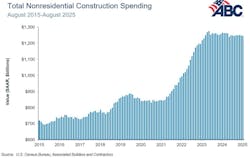Nonresidential Construction Spending Down in August
Key Highlights
- Nonresidential construction spending decreased by 0.2% in August, totaling $1.24 trillion annually;
- The manufacturing and commercial segments are particularly weak, while data centers continue to see growth due to higher contractor backlog;
- Private nonresidential spending declined by 0.3%, and public sector spending fell by 0.1%.
- Economic factors like high borrowing costs, tariffs, and government shutdown effects are impacting industry growth.
- The industry faces potential difficulties in the coming quarters due to rising costs and economic uncertainty.
WASHINGTON, Nov. 17 — National nonresidential construction spending decreased 0.2% in August, according to an Associated Builders and Contractors analysis of data published today by the U.S. Census Bureau. On a seasonally adjusted annualized basis, nonresidential spending totaled $1.24 trillion.
Spending was down on a monthly basis in 10 of the 16 nonresidential subcategories. Private nonresidential spending was down 0.3%, while public nonresidential construction spending was down 0.1% in August.
“Nonresidential construction spending contracted for the third time in the past four months in August and is now down 1.5% year over year,” said ABC Chief Economist Anirban Basu. “The manufacturing and commercial categories have been particularly weak in 2025, while momentum remains confined almost exclusively to the data center segment. This should come as no surprise given that approximately 1 in 7 ABC members are under contract to work on a data center, and those contractors have significantly higher backlog than those that are not, according to ABC’s Construction Backlog Indicator survey.
“Of course, this data pertains to August and reflects neither the effects of the government shutdown nor the cost-raising potential of tariffs that were implemented at the start of that month,” said Basu. “With private nonresidential activity buckling under the weight of high borrowing costs, extraordinarily elevated uncertainty and rising materials costs, a slowdown in public sector work could lead to a particularly difficult few quarters for the industry.”


